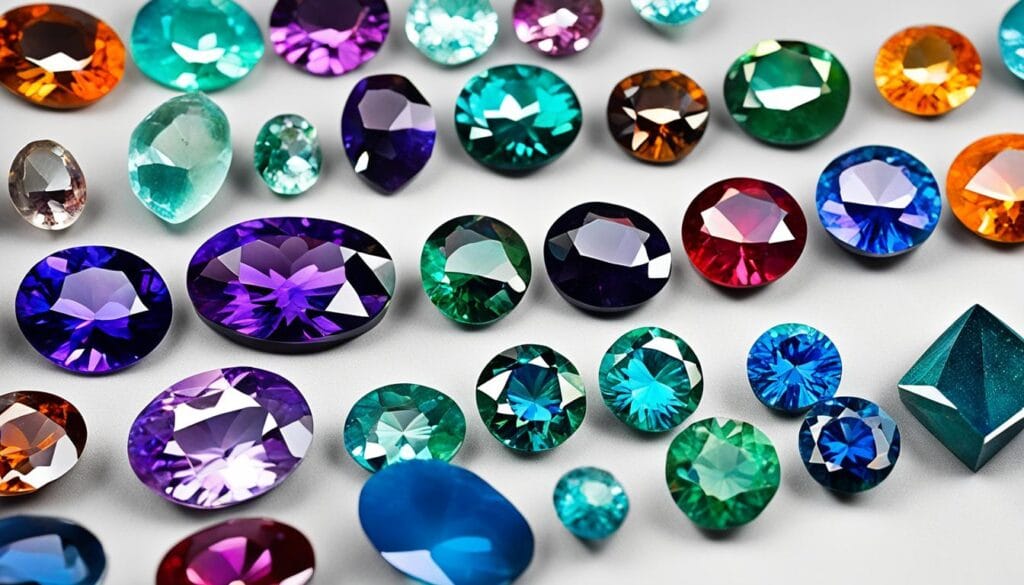Gemology is the study of gems and precious stones. It blends geology, mineralogy, and jewelry design. This guide will show you the amazing world of gemstones. You’ll learn about their origins, how to identify them, and how they become jewelry.
If you love gems or just find them beautiful, this article is for you. It will light up your interest in gemology. Get ready for a journey into the science and beauty of gemstones.

Key Takeaways
- The global gemstone market is expected to surpass $31 billion by 2027, highlighting the enduring appeal of precious stones.
- Gemology is a multidisciplinary field that combines geology, mineralogy, and the art of jewelry design.
- This guide will explore the geological origins, identification techniques, and transformation processes of gemstones.
- The article is tailored for both seasoned gem enthusiasts and those fascinated by the beauty of the natural world.
- Readers will embark on an enlightening journey through the science, art, and splendor of the gemstone universe.
What is Gemology?
Gemology is the study of precious and semi-precious stones. It’s a branch of mineralogy that looks into the science of gemstones. Gemologists use special tests and tools to learn about each stone’s makeup and value.
Exploring the Science Behind Precious Stones
Gemology combines many sciences like mineralogy, crystallography, and optics. Experts study the stones’ makeup, structure, and how they work. This helps them figure out what makes each gemstone special.
Gemstone Identification and Classification
Identifying and classifying gemstones is key in gemology. Experts use tools and methods to check a stone’s color, clarity, and shape. This lets them know what kind of gemstone it is and how valuable it is. Knowing this is vital in the jewelry world.
“Gemology is the pursuit of understanding the natural world through the lens of precious and semi-precious stones.”
The Art of Gem Appraisal
In the world of gemology, gem appraisal is a key skill. Experts with a sharp eye and deep knowledge check a gemstone’s quality, rarity, and value. They look at its cut, color, clarity, and weight, plus its history and special features.
Knowing what a gemstone really is and how good it is is key to figuring out its value. Gemologists use special tools and their knowledge to check every part of the gem. They make sure they see the gem’s full value, from diamonds to sapphires, each with its own story.
Appraising gems is a mix of science and art. Gemologists need to know about the geology, chemistry, and how light affects gems. This lets them understand the gem market and give clients a detailed value check.
If you love gems or just find them interesting, gem appraisal opens up the world of gemology. It shows us the beauty of these stones and the experts who find their true value.

“The true value of a gemstone lies not only in its physical attributes but also in the stories it has to tell.”
Understanding the Formation and Properties of Gemstones
Gemologists study how gemstones come to be. This helps them understand what makes each one unique. It also helps them figure out how valuable these stones are.
Diamonds form under extreme heat and pressure deep in the Earth. Over millions of years, carbon turns into the sparkling diamonds we love. Rubies, emeralds, and sapphires get their colors from elements that were there when they formed.
| Gemstone | Primary Elemental Composition | Formation Process |
|---|---|---|
| Diamond | Carbon | High heat and pressure in the Earth’s mantle |
| Ruby | Aluminum oxide with chromium | Crystallization in metamorphic rocks |
| Emerald | Beryllium aluminum silicate | Precipitation in hydrothermal veins |
Knowing how gemstones form and what makes them special helps gemologists. They can then make better choices about their value and authenticity.

Crystallography: The Geometric Beauty of Gemstones
In the world of gemology, crystallography is key to understanding gemstones’ beauty and complexity. These stones have unique geometric structures. Each one has its own symmetry and optical properties. From diamonds’ sharp facets to the colors of certain gems, their crystal structures show the beauty of nature.
Symmetry, Structures, and Optical Properties
Crystallography helps gemologists identify gemstones and see their beauty. It shows how a gemstone’s structure affects its optical properties. This includes how it bends, spreads, and reflects light. These properties make each gemstone unique and fascinating.
Learning about crystallography helps us understand how gemstones form and what makes them special. This knowledge deepens our appreciation for nature. It also helps gemologists identify and value these stones better.

